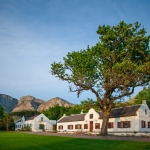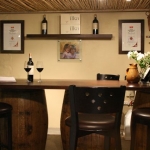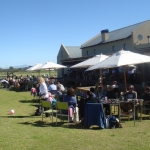DURBANVILLE WINE VALLEY – REGIONAL DISH
After a brush with “cuisine du terroir” in France in 2010, Thys Louw, our host and sixth generation wine farmer at Diemersdal, returned to the hills of Durbanville with an idea – to identify and develop a range of dishes which would express the terroir of his chosen home, Diemersdal wine farm. A cuisine to complement the increasingly notable (and noted) wines of the area beyond the manor house, at this time of the year a plaid green cloth of budding vines, stretched over a number of hills tucked away to the West of Cape Town.
As most things worth attention, these dishes would have to be as original as commonplace; would have to express history and place as much as, somehow, being without precedent.
A year later there’s a press release; a lunch. Food people and notables gathering noisily to sample the Regional Dish. On the sideboard: stampkoring, braced with a purée of pumpkin, its subtly quaint flavour of earthy wheat and sweet vegetable emboldened with a reduction of lamb jus, cumin and red wine. We each receive a lump, studded with a few cubes of golden grilled butternut; some green salad. Huddling close on the plate, as if to stay warm: two skewers of plump, tooth-tempting lamb cubes, braaied outside, redolent of Malay spice, onion, a cooked marinade: sosaties. The recipe said to be a wedding present to Ladine from Elrita Blanckenberg of the Kaaimanskloof farm. Next to this: pampoenpiekel, dotted with a few dark mustard seeds. Never out of arms length a bevy of two-tone bottles: Merlot and Sauvignon Blanc from the surrounding farms – Altydgedacht, Bloemendal, D’Aria, De Grendel, Durbanville Hills, Hillcrest, Groot Phisantekraal, Klein Roosboom, Meerendal, Nitida, their own Diemersdal wines. History, skill, people, place – at once stepping into the white-lit circle of a plate. Bottles of wine its ready souffleurs.
Says Bill Bryson: “whatever happens in the world — whatever is discovered or created or bitterly fought over – eventually ends up, in one way or another, in your house.” As frequently history starts in a house – around a table and food and people – before it wanders off to perform its proper tasks: memory and change. Go anywhere and there will people in their homes, partaking of some kind of food – few things create a sense of place as much as what’s being eaten. Or drunk, for that matter.
Dessert arrives: a cake of cream cheese filled Cambrieni, topped with sugared fruit, nuts, ginger in syrup. A few pumpkin seeds, I notice – the farm used to be called Pampoenkraal, after all. As accompaniment: gemmerkoekies and a bottle of Altydgedacht noble late harvest; the first sip exploding with the flavour of caramelised ginger. I enquire, with some surprise. “No, it amplifies the ginger flavour” motions a journalist from across the table and smiles thoughtfully at what he has just said.
Amplifies. Indeed.
Participating wineries will have this dish available in their restaurants from the 1st of December at R120.00 for a main course or R65 for a starter portion. A vegetarian option will be made available for diners preferring a meatless option. The regional dish will also be served during the Feast of the Grape and other wine festivals at all the member farms: Nitida, Meerendal, Hillcrest, Klein Roosboom, Groot Phisantekraal, Durbanville Hills, Diemersdal, De Grendel, D’Aria, Bloemendal and Altydgedacht.
For more information please contact the Durbanville Wine valley: 083 310 1228 or www.durbanvillewine.co.za
Jacques van Zyl
www.biodynamiclongtable.com
.








There are no responses so far.